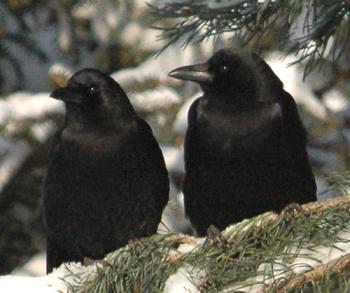Crows are Nature’s Scamps

American crows
Photo credit: Jim Williams
by Val Cunningham
Contributing Writer
Love them or hate them, crows are some of the smartest and most adaptable birds around, and they’re a lot like us.
People seem to be of two minds about crows. Some of us admire these big black birds for their intelligence, inquisitiveness, playfulness and other sterling qualities. But others despise crows for their raucous calls, messing with garbage and nasty habit of carrying off other birds’ eggs or nestlings.
In their defense, crows are good parents, have stable family relationships and gather with others of their kind, often in cities. They’re very adaptable, able to thrive in just about any habitat so live happily everywhere in the continental United States. Who else does this sound like? Yes, people and crows do have a lot in common, maybe more than many of us want to believe.
Crows used to be rural birds, but were relentlessly slaughtered in efforts to control their predation on grain crops. Around the 1950s crows figured out that life is easier in urban areas. After all, cities prohibit the shooting of birds and there’s a continually replenished supply of food on streets, at shopping centers and in dumpsters. Many cities also provide an urban forest, perfect for nesting and roosting at night.
I’m very fond of crows and have learned that it’s worthwhile to keep an eye on them—they’re always up to something. There’s no denying that crows are smart: bird researchers John Marzluff and Tony Angell even assert that “mentally, crows and ravens are more like flying monkeys than they are like other birds.”
Their big, active brains allow them to quickly solve the problems of survival each day, leaving plenty of time for what some biologists call gratuitous behavior—anything that’s not related to breeding or surviving. Basically, crows have time to have fun. (For a treat, read David Quammen’s essay, “Has Success Spoiled the Crow?” in Natural Acts, A Sidelong View of Science and Nature.)
For fun, they’re known to drop sticks in the air then swoop down to catch them before they hit ground, over and over. Crows have been reported purposefully sliding down snow-covered rooftops. I once saw a group of crows tumbling down a short, snowy hill on a winter day, running back to the top time and again to have another slide. And check the skies on breezy days in spring and fall to see crows exuberantly soaring and swooping in the wind. Yes, crows know how to have a good time.
By late summer, this year’s young crows are roaming the neighborhood, learning the omnivore ropes from their parents and often an older sibling from an earlier nest who’s spending a year or two as a helper at the nest.
Clean-up crew
Crows perform a service as nature’s clean-up crew, scooping up road kill from our streets. However, much of their diet is fresher fare, including earthworms, fruits, nuts, seeds, grains, small animals and insects. Although they’re known to have a large vocabulary of sounds, crows don’t sing to attract a mate or define a territory as other songbirds do (yes, crows are classed as songbirds). They communicate with each other via a variety of calls and seem to end each day with a loud gossip session before roosting for the night.
Crows from coast to coast have been hit hard by West Nile Virus, with the Midwest population devastated by this disease. There are noticeably fewer crows in the metro area these days, a fact that pleases many, but not us fans of crows. I’m hoping for the day when these handsome birds are again a common sight, strutting through our parks, cawing from the trees and just generally causing mischief.
Val Cunningham, who writes about birds for many publications, is also a field trip leader for St. Paul Audubon and conducts IBA and Breeding Bird Atlas surveys. A version of this piece appeared first in the Minneapolis StarTribune.



